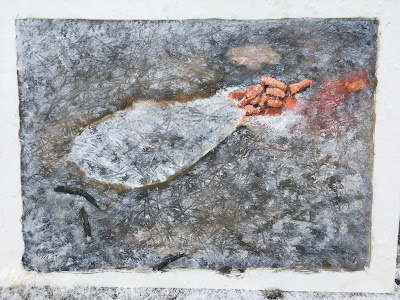 |
| Pulken, 17-01-2021, oil on acid free cardboard 30 cm x 21 cm |
Now you may wonder what this is? The day before yesterday, when I took yet another walk in Pulken, I noticed the numerous heaps of goose excrement scattered on the ice. Some deposited in little heaps, others cast into the ice as clouds of orange, green, or white, while the ice itself ranged from deep black over dirty ochraceous hues to the purest sky blue. I decided that this was something to paint, and today I made a go for it.
In the meantime a slight drizzle of snow had fallen, and as a result of this a structure, that I had hitherto missed, had become obvious: Egg shaped dark outlines around a slight depression in the ice, which again stood out more white than the surrounding ice surface - simply because a little more snow had gathered there.
Looking at them I noticed that all of these egg shapes had a pile of goose excrement at the more pointed end and suddenly I realized what this was: Each of these shapes marked the place where a goose had been sleeping on the night that the water froze! During the night the geese had first deposited their excrement in the water - thus the differently colored clouds cast into the ice - later, when the water had frozen, the excrement had landed on top of the ice as little heaps. All the while the body heat from the sleeping goose had held the water open, so that when it left its night quarters a little egg- or rather goose shaped water surface was left. Only then had this water frozen. The dark outline was a result of the ice being pushed just a little by the goose, producing a slight elevation around the depression, and on this elevation it was, for obvious reasons, harder for the snow to settle, which explains the dark outline.
Maybe you can guess what the goose that made the droppings, which I have painted, had been eating on the day before?
It turned out that I began painting in the very last moment. As I settled down and anticipated working, snow began falling and while painting my motif turned whiter and whiter. To me this is a new angle on observing the thousands of geese using Pulken as a night roost. It also illustrates a problem. As winters grow ever warmer more and more geese winter in southern Scandinavia. Especially greylag geese, which are now wintering far north of their former winter quarters, and barnacle geese. The latter used to be quite scarce - I managed to watch birds for several years before ever seeing one. Now they are abundant. Both species have experienced a tremendous growth in population. The droppings from all these geese are now threatening to destroy the ecosystems of the lakes in which they spend the winter nights.
In Pulken, though, I do not think that this is a real problem so far. Here the bulk of the wintering geese are taiga bean geese, 2000-5000 I should say, and as far as I know this is the way it has been at least for decades. On a global basis the taiga bean goose is rather rare, and to them Skåne is the traditional wintering ground. They only migrate further to the south west on a larger scale if Skåne becomes totally ice bound. Some greylag geese are present here this winter, but still their numbers at Pulken hardly surpass 500. A couple hundred barnacle geese are also around while tundra bean geese are apparently scarce, as are white fronted- and pink-footed geese.
 |
| Geese on Pulken in the very first morning sun, still at their night roost. This one I painted before the water froze. Oil on cotton paper, 37 cm x 17,3 cm. |
 |
| Me painting on the ice. |

